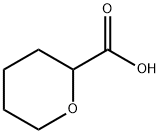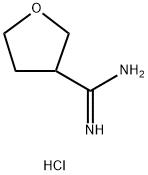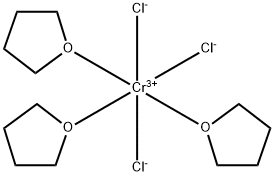Tetrahydrofuran-3-carboxaldehyde
- CAS NO.:79710-86-4
- Empirical Formula: C5H8O2
- Molecular Weight: 100.12
- MDL number: MFCD02101976
- EINECS: 629-664-5
- SAFETY DATA SHEET (SDS)
- Update Date: 2025-07-16 09:52:21

What is Tetrahydrofuran-3-carboxaldehyde?
The Uses of Tetrahydrofuran-3-carboxaldehyde
2-(Tetrahydrofuran-3-yl)acetaldehyde is a reagent used in the preparation of several pharmaceutical agents. It is used in the prepoaration of ortho-amino benzamides and nicotinamides as MCHr1 (Melanin-concentrating hormone receptor 1) antagonists, used in the therapeutic treatment of obesity. Also used in the pereparation of Tsg101-directed HIV-1 budding antagonists for application towards late-stage HIV-1 infection.
General Description
The product is a 50 wt.% solution of tetrahydrofuran-3-carboxaldehyde in water.
Hazard
A mild eye irritant.
Properties of Tetrahydrofuran-3-carboxaldehyde
| Boiling point: | 99 °C |
| Density | 1.106 g/mL at 25 °C |
| refractive index | n |
| Flash point: | >230 °F |
| storage temp. | 2-8°C |
| form | Liquid |
| EPA Substance Registry System | 3-Furancarboxaldehyde, tetrahydro- (79710-86-4) |
Safety information for Tetrahydrofuran-3-carboxaldehyde
| Signal word | Danger |
| Pictogram(s) |
 Corrosion Corrosives GHS05 |
| GHS Hazard Statements |
H318:Serious eye damage/eye irritation |
| Precautionary Statement Codes |
P280:Wear protective gloves/protective clothing/eye protection/face protection. P305+P351+P338:IF IN EYES: Rinse cautiously with water for several minutes. Remove contact lenses, if present and easy to do. Continuerinsing. |
Computed Descriptors for Tetrahydrofuran-3-carboxaldehyde
New Products
4,4-Difluoropiperidine hydrochloride tert-butyl 9-methoxy-3-azaspiro[5.5]undecane-3-carboxylate Indole Methyl Resin N-Isopropylurea N,N-Dicyclohexylcarbodiimide(DCC) MELDRUMS ACID 5-METHYLISOXAZOLE-4-CARBOXYLIC ACID Magnessium Bis glycinate Zinc ascorbate 1-bromo-2-butyne 2-acetamidophenol 9(10H)-anthracenone Erythrosin B, 4-Piperidinopiperidine 2-((4-morpholinophenylamino) (methylthio) methylene) malononitrile 2,4-dihydroxybenzaldehyde 3-(4-morpholinophenylamino)-5-amino-1H-pyrazole-4-carbonitrile Methyl 2-methylquinoline-6-carboxylate 2,6-dichloro-4-nitropyridine 4-Bromo-2-chlorobenzonitrile 2-(benzylamino)acetic acid hydrochloride 4-(tert-Butoxycarbonylamino)but- 2-ynoic acid 3,4-dihydro-2H-benzo[b][1,4]dioxepine 1-Phenyl-1-cycloprppanecarboxylicacidRelated products of tetrahydrofuran





![tetrahydrofuro[2,3-b]furan-2(3H)-one](https://img.chemicalbook.in/CAS/20200331/GIF/104223-37-2.gif)


You may like
-
 Tetrahydrofuran-3-carbaldehyde CAS 79710-86-4View Details
Tetrahydrofuran-3-carbaldehyde CAS 79710-86-4View Details
79710-86-4 -
 Tetrahydrofuran-3-carboxaldehyde solution CAS 79710-86-4View Details
Tetrahydrofuran-3-carboxaldehyde solution CAS 79710-86-4View Details
79710-86-4 -
 3-(4-amino-1-oxoisoindolin-2-yl)-1-methylpiperidine-2,6-dione 98%View Details
3-(4-amino-1-oxoisoindolin-2-yl)-1-methylpiperidine-2,6-dione 98%View Details -
 614-19-7 98%View Details
614-19-7 98%View Details
614-19-7 -
 20677-73-0 (2,2-diethoxyethyl)methylamine 98%View Details
20677-73-0 (2,2-diethoxyethyl)methylamine 98%View Details
20677-73-0 -
 3-(4-(hydroxyamino)-1-oxoisoindolin-2-yl)piperidine-2,6-dione 98%View Details
3-(4-(hydroxyamino)-1-oxoisoindolin-2-yl)piperidine-2,6-dione 98%View Details -
 57381-49-4 2-bromo-4-chlorobenzonitrile 98%View Details
57381-49-4 2-bromo-4-chlorobenzonitrile 98%View Details
57381-49-4 -
 4,6-dichloropyrimidine-5-carbaldehyde 98%View Details
4,6-dichloropyrimidine-5-carbaldehyde 98%View Details
5305-40-8
Statement: All products displayed on this website are only used for non medical purposes such as industrial applications or scientific research, and cannot be used for clinical diagnosis or treatment of humans or animals. They are not medicinal or edible.
